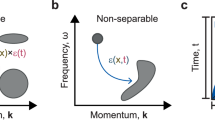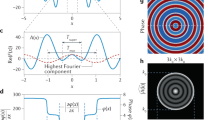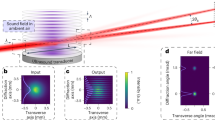Abstract
F. H. SANDERS1, in a recent note in these columns, has reported excellent agreement between our theory and his experimental results. His note, however, calls for a statement from us clarifying the theoretical position. As is well known, Debye and Sears in America and Lucas and Biquard in France discovered, in 1932, that a beam of light after passing through a supersonic field breaks up into a fan of diffraction spectra. Following this discovery, Prof. R. Br, of Zurich, carried out extensive investigations regarding the nature of the phenomenon; he obtained numerous beautiful results concerning the manner in which the relative intensities of the various diffraction spectra depend on the wave-length of light, the supersonic intensity and the thickness of the cell. He also discovered that the frequencies of light in the diffracted spectra are modulated by the sound field in a very peculiar manner depending on the order of the spectrum.
This is a preview of subscription content, access via your institution
Access options
Subscribe to this journal
Receive 51 print issues and online access
$199.00 per year
only $3.90 per issue
Buy this article
- Purchase on SpringerLink
- Instant access to full article PDF
Prices may be subject to local taxes which are calculated during checkout
Similar content being viewed by others
References
F. H. Sanders, NATURE, 138, 285 (1936).
C. V. Raman and N. S. Nagendra Nath, Proc. Ind. Acad. Sci., 2, 406 and 413 (1935); 3, 75, 119 and 459 (1936). N. S. Nagendra Nath, Proc. Ind. Acad. Sci., 4, 222 (1936).
R. Br, Helv. Phy. Acta, 9, 265 (1936).
S. Parthasarathy, Proc. Ind. Acad. Sci., 3, 549 (1936).
Author information
Authors and Affiliations
Rights and permissions
About this article
Cite this article
RAMAN, C., NAGENDRA NATH, N. Diffraction of Light by Ultra-Sonic Waves. Nature 138, 616 (1936). https://doi.org/10.1038/138616a0
Issue date:
DOI: https://doi.org/10.1038/138616a0



